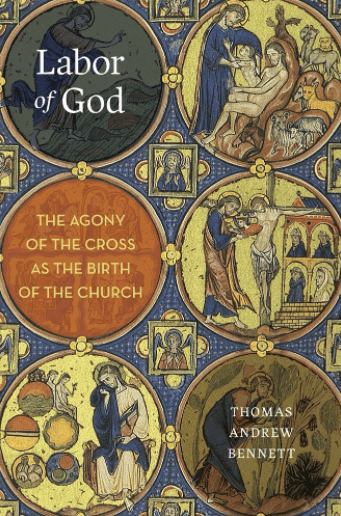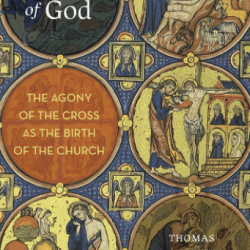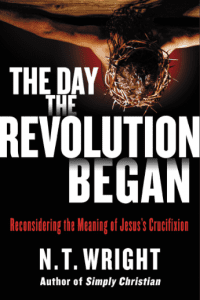 When Richard Bauckham, Murray Rae, and Michael Gorman lend their name to a book on atonement, I’m all ears. They’ve done so to Thomas Andrew Bennett’s elegantly written new (and not long) study, Labor of God: The Agony of the Cross as the Birth of the Church. This is not one of those “the church got it all wrong” books but instead a book that suggests one theme — childbirth, becoming children of God, or in the big theme “God in labor” — can be a fresh entry point for understanding the complex set of ideas at work in any understanding of the atonement. The book is beyond refreshing.
When Richard Bauckham, Murray Rae, and Michael Gorman lend their name to a book on atonement, I’m all ears. They’ve done so to Thomas Andrew Bennett’s elegantly written new (and not long) study, Labor of God: The Agony of the Cross as the Birth of the Church. This is not one of those “the church got it all wrong” books but instead a book that suggests one theme — childbirth, becoming children of God, or in the big theme “God in labor” — can be a fresh entry point for understanding the complex set of ideas at work in any understanding of the atonement. The book is beyond refreshing.
The biggest problem I see in atonement discussions is the incompleteness of framework: that is, atonement isn’t located in the bigger story of the Bible of both creation and ultimate new-heavens-new-earth kingdom story. Thus, it falls for a minor motif (theodicy, etc) in the larger story and abstracts theology from the living reality of what God is accomplishing.
Bennett has the potential to connect atonement to the big story.
Here is a taste both of Bennett’s prose and the big ideas of the book.
Among these tendrils and roots, there is one image in particular that has cropped up from time to time, in the thoughts and writings of mystics and anchoresses, church fathers and mothers. It is an image of the cross that burst forth in visions and was then abruptly dropped, left by the wayside in systematic, doctrinal work. Perhaps the implications of this way of framing cross-thought were simply too radical—if such a thing is even possible—for theology to comprehend. Like classical Pauline images of the cross, it is strange and unruly, picturing the cross—surely the paradigmatic expression of despair—as surprisingly hopeful. Like the image of sacrifice it does not shrink from crucifixion’s physical horror, but unlike sacrifice it does not trade in the conceptual economy of victims and perpetrators. It eschews, in fact, notions of economy entirely, radically opposing the cross to the language of exchange, of this for that, him for us. And yet it does so without losing the concept of cost, of the truth that whatever Jesus’ crucifixion accomplished, it did so only at great physical, emotional, and psychological cost to the man Jesus and, possibly, the implicated Godhead. Like the image of victory, this overlooked metaphor, this biblical but not merely exegetical image, this ignored root from the Christian tradition, pictures the cross as embodied, costly exertion that succeeds. But the victory embedded in it is different from classical articulations of Christus Victor, for this fresh vision of the cross does not picture invisible forces or spiritual adversaries as the agents of our oppression. It instead remembers in the best Christian way that it is ultimately the corrupting influence of sin that must be defeated, and it makes sense of how the cross can actually do this.
This image, the one that really can revivify a teologia crucis for the twenty-first century, ultimately draws its power from a deep connection to genesis, that is, origination. It evokes a semantic field that encompasses growth, new life, a fresh start, and the rhythms of the known, observable universe wherein pain and sometimes death are the fertilizers out of which new life springs. And this is how it accounts for the change that Christians confess the cross brings to persons, communities, and even the world itself. It is able to conceptualize coherently an instrument of denigration and torture as the process or mechanism out of which newness comes, new life for people as well as th eir environs.
In this largely unnoticed strand of Christian theology, the crucifixion of Jesus of Nazareth is known as the birthing pangs—the labor—of God, who bears renewed, spiritual sons and daughters into the world. The blood and water that poured from Jesus are the blood and water that have accompanied every infant that has entered the world. The scarring harm, unavoidable and intrinsic to birth, marked too the body of the incarnate, laboring God. New life and new hope, long the prize and purpose of labor, spring forth in the Spirit from the mothering Jesus, incarnating into a dying world spiritual sons and daughters, possessors of God’s own inextinguishable life and heritable character. The cross is the labor of God. And in theological reflection drawn from this image, we argue that contemporary Christian atonement theology may once again recover the brazen, dissonant, radically gracious self-giving love of God (4-5).
Bennett finds his starting point in Johannine literature (John 3:37, 7; Titus 3:5; 1 Peter 1:23), and finds echoes of God in labor in Anselm, Julian of Norwich, Marguerite d’Oingt, feminist theology, as well as in Murray Rae. Here’s the thrust:
The language of second birth is therefore suggestive; it hints at theological depths in a way that other metaphors in John do not. It is enigmatic, forcing us to ask, “What is birth from above for John? What does it signal?” In short, “birth from above” takes place in Jesus’ crucifixion, and it signals the process by which human beings become natural children of God. In and through the cross, a fundamental change takes place in the relations holding between human beings, Jesus, and the Father—and the change implicates family and, in twenty-first century terms, DNA. At the cross, Jesus labors to bring humanity into God’s family. He gives us our second birth (8).
When creation is tied to redemption and to new creation, we are on to something vital. How’s this for a suggestive, if not provocative, opening?
If an essential feature of a faithful proclamation of the cross is radicality, then we may expect to shock and be shocked as Mother Jesus and the labor of God reconfigure what the church teaches about reconciliation in and through a humiliating death (14).










